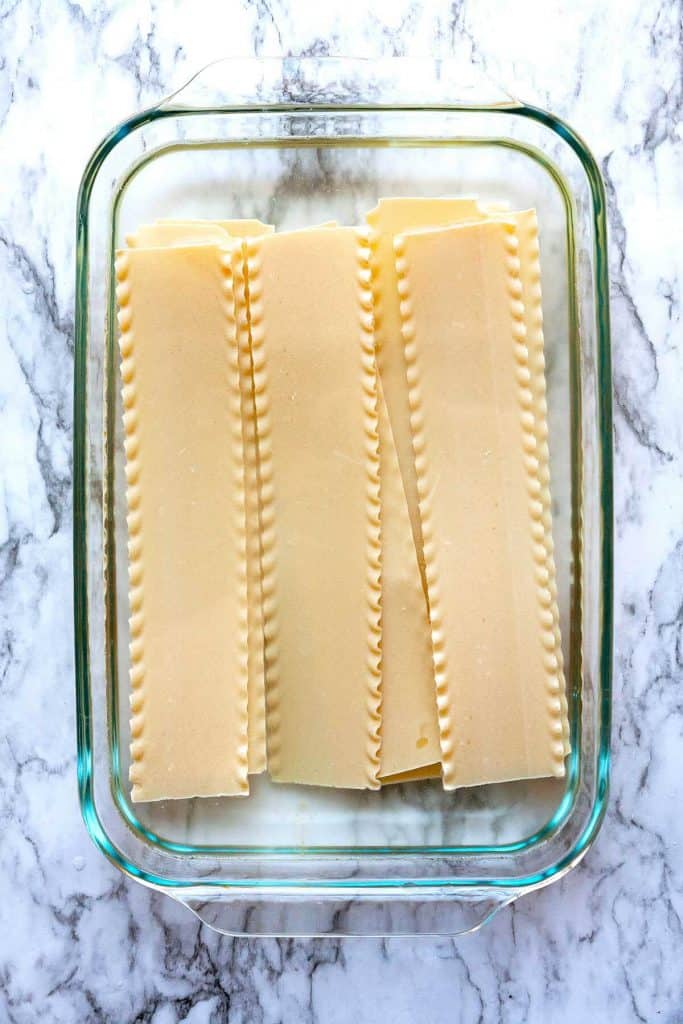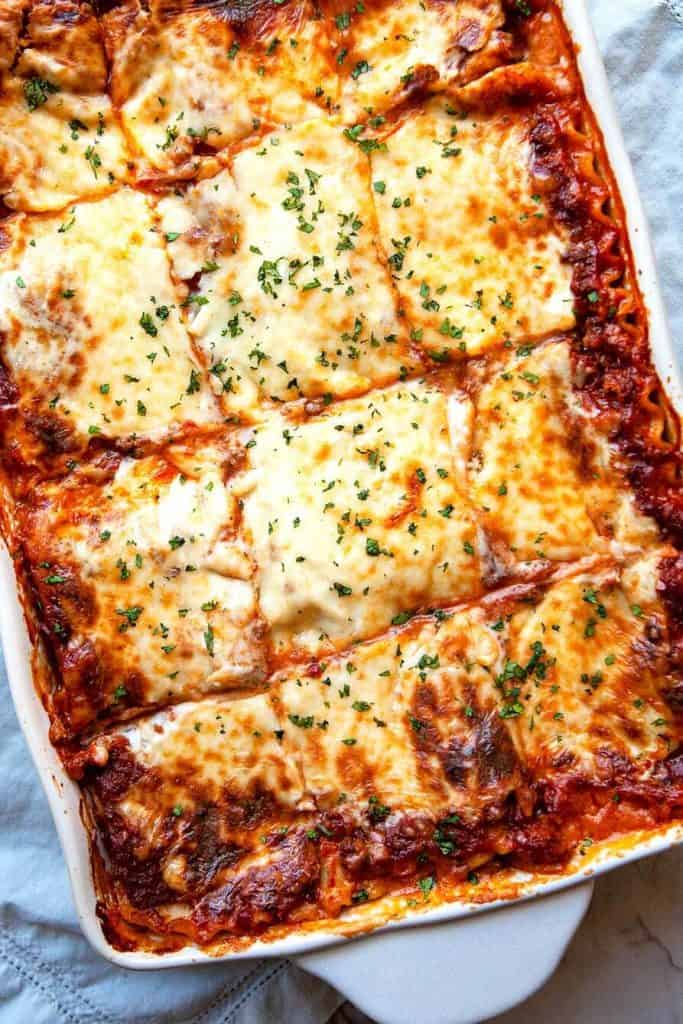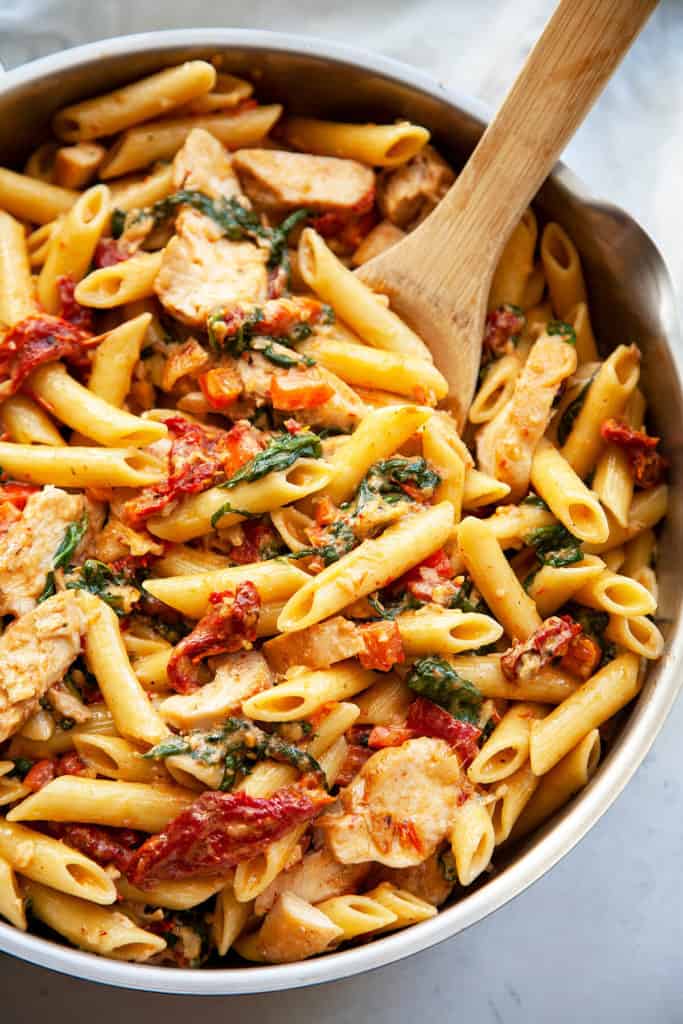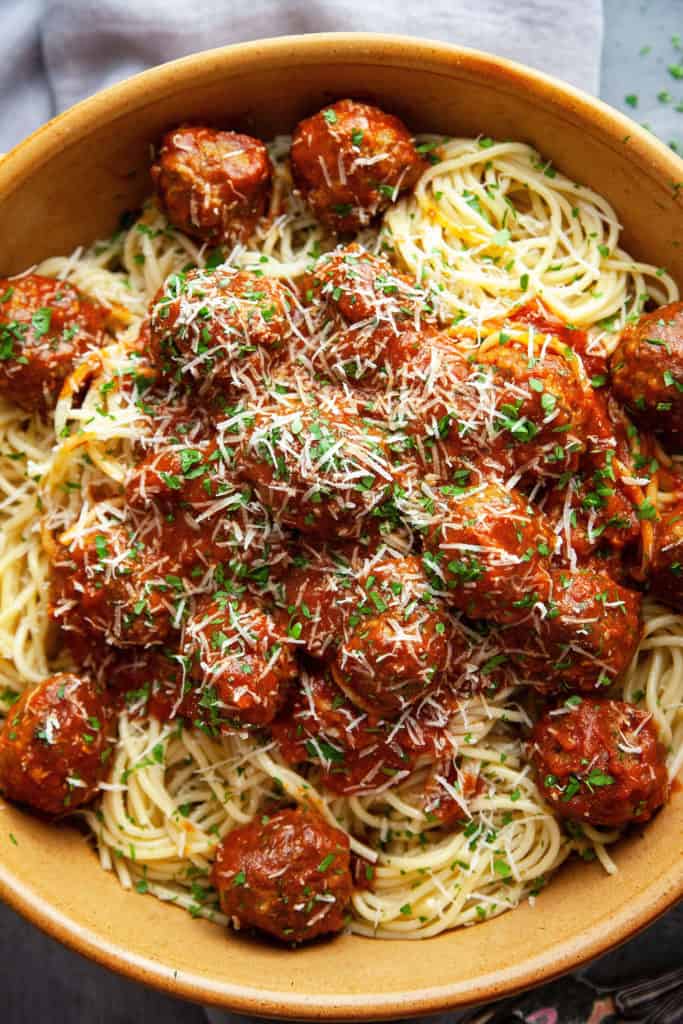Jump to Section
World’s Best Lasagna Recipe
Classic Italian Lasagna - layers of silky smooth, creamy parmesan béchamel sauce, a slow simmered Bolognese meat sauce, sheets of pasta, and lots of mozzarella cheese make this the World’s Best Lasagna recipe.
Classic Lasagna Recipe with Béchamel Sauce
This traditional Lasagna, from Northern Italy’s Emilia-Romagna region, uses an easy béchamel sauce instead of ricotta cheese. Béchamel is a creamy, silky smooth white sauce made by whisking hot milk into a roux made of flour and butter.
Parmesan is whisked into the sauce giving it extra flavor which technically makes it a mornay, or cheese sauce. It’s a fancy name, but don’t worry, it’s quick and simple to make.
My family doesn’t like the grainy texture of Lasagna baked with ricotta. I’ve tried mixing it with sour cream and even substituting cottage cheese to avoid the graininess. Nothing beats a silky smooth béchamel sauce.
In Southern Italy you’ll find Lasagna made with creamy fresh ricotta that isn’t grainy like much of the ricotta found here in the US.

Lasagna or Lasagne?
In Italian, Lasagna means one sheet of pasta (or noodle) and Lasagne is the plural. So a dish of Lasagna noodles baked in the oven is Lasagne al forno. However, in the rest of the world, it’s usually just called Lasagna.
Lasagna Bolognese - Lasagne alla Bolognese
Lasagna Bolognese is an Italian classic of ragù Bolognese and creamy béchamel, layered with sheets of fresh or dried pasta.
The ragù alla Bolognese sauce is a meat based Italian sauce used for pasta, with the addition of tomato, and a base of soffritto – small diced onion, carrot, and celery, sautéed in butter or oil until soft and golden.
Bolognese sauce also has added dairy, usually milk. Simmering the meat in milk gives a richer depth of flavor and adds to the silkiness of the sauce. In this recipe, I have left out the added wine.
The sauce is left to slowly simmer and develop its flavor for about three hours. If I’m home and have the time, I let it simmer. I’ve found that even an hour of simmering improves the flavor. If I’m in a hurry, I simmer it about 20-30 minutes while I get the rest of the ingredients together.

Easy Homemade Lasagna Recipe
This Classic Lasagna recipe is easy to make. The ragù sauce can cook for as little or as long as you like, depending on how much time you have. The béchamel sauce is just a matter of whisking hot milk into butter and flour. With my easy tip for soaking the noodles, there’s no fussing with cooking them.
Ingredients in traditional Italian Lasagna
Ragù sauce – a meat based Italian sauce for pasta with a base of sautéed onions, carrot, and celery and the addition of tomato.
Béchamel sauce – an easy to make white sauce. Simply whisk hot milk into a flour and butter. With parmesan for added cheesy flavor.
Lasagna noodles – fresh sheets or dried lasagna noodles.
Mozzarella – spread in between the layers and on top.
Lasagna Noodles
For traditional Lasagne alla Bolognese, the thinnest fresh pasta sheets are used. While this is the ultimate decadence in lasagna, not everyone has the luxury of time to roll out fresh pasta. I can sometimes find fresh pasta sheets in my supermarket.
I’ve used dried lasagna noodles in this recipe because it’s a staple I have in my cupboard, and it’s accessible to everyone. Plus, it saves time.
Use as many noodles as will make 3 layers in your baking dish. My dish gets wider towards the top so I use 3 sheets on the bottom layer, and 4 sheets each for the middle and top layers.
How to make
Make the Bolognese sauce
- Chop the onion, carrot, and celery very fine. If it’s too big, it might not get soft enough in the sauce. I like to chop mine up in the food processor.
- Sauté the chopped onion, carrot, and celery in butter and olive oil until it is soft and golden. Add the garlic and sauté another minute.

- Add the ground beef and cook until brown, breaking it up into small pieces, and all of the liquid is absorbed.
- Pour in a cup of milk and let simmer until the liquid is absorbed. (If I’m in a hurry, I skip this step, but it does mellow the flavor and add a silky texture to the sauce.)

- Add the crushed tomatoes, Italian seasoning, bouillon cube, salt, pepper, sugar, and vinegar. Bring to a simmer. If I’m in a hurry, I allow it to simmer for about 30 minutes, however a long, slow 3 hour simmer is best if you have the time.
- When the sauce is finished, it should be thick as shown here. If it has too much liquid, it will be messy when cut.
- I like to stir in some chopped fresh basil when it’s done. This lightly dried basil from Walmart is pretty cool when it's hard to get a hold of fresh basil. It stays fresh for 4 weeks after opening.

Make the Béchamel sauce
- Melt butter in a skillet over medium-high heat.
- Whisk in the flour until a smooth roux forms. Let cook about 30 seconds.
- Whisk in hot milk, and stir until the sauce thickens and can coat the back of a spoon.

- Take off the heat and whisk in parmesan until melted. Cover and set aside. If a skin forms on top, just stir it in before using, it will dissolve.
- Add a pinch of nutmeg. Salt and pepper to taste.

Soak the dried lasagna noodles
There's no need to boil dried lasagna noodles. If you’re using dried lasagna noodles, thirty minutes before assembling the lasagna, soak the noodles in hot tap water. Don’t let them soak longer than 30 minutes or they will become too soft, then become mushy in the baked lasagna.

How to Layer
- Spread ¼ of the ragù sauce, about 2 cups, onto the bottom of a 9 by 13 inch baking dish.

- Top with a layer of lasagna noodles or fresh pasta sheets.

- Spread on ¼ of the ragù sauce, about 2 cups

- Spread on ⅓ of the béchamel sauce, about 1 ⅓ cups

- Sprinkle with ⅓ of the mozzarella, about 1 ⅓ cups

Make 2 more layers:
- noodles, ¼ ragù, ⅓ béchamel, ⅓ mozzarella
- noodles, ¼ ragù, ⅓ béchamel, ⅓ mozzarella

How to prevent the lasagna from sticking to the foil
Cover the Lasagna with foil that has been sprayed with nonstick baking spray.
If your Lasagna layers go up to the top of the pan, put in some sticks near the 4 corners of the dish. I use chopsticks that are broken in half. This will prevent the foil from touching the top layer of cheese.

How Long to Bake
Cover the Lasagna with foil and bake for 20 minutes in a 375 F oven. After 20 minutes, remove the foil (and the sticks if using) and continue to bake for another 30 minutes until bubbly and the cheese on top starts to get brown spots.
You can turn on the broiler for the last minute or two to get the browning you desire. Keep a close eye on it though!

How to make in advance
Both the ragù sauce and the béchamel sauce can be made a day or two in advance and kept in the refrigerator. Allow extra time for baking since they will be cold when assembling the Lasagna.
How to freeze before baking
I find that Lasagna is better if it is frozen before baking.
- Use a freezer friendly baking dish. I use pyrex glass pans.
- Line the baking pan with foil before assembling the Lasagna if you want to remove the Lasagna from the dish while storing in the freezer. This allows you to easily lift the frozen Lasagna out of the pan so you can use the pan while the Lasagna is in the freezer.
- Chill the Lasagna in the refrigerator for several hours. This way it will freeze faster and have less chance for getting freezer burn.
- Wrap the assembled, unbaked Lasagna tightly in several layers of foil.
- If you are removing the Lasagna from the baking dish, remove it now and rewrap it in the foil.
- For extra protection you can put it in a 2.5 gallon freezer bag. Press out as much of the air as possible or use a straw to suck out most of the air. This will help prevent ice crystals from forming.
- Lasagna can be frozen for up to 3 months.
How to bake frozen Lasagna
Thaw Lasagna completely in the refrigerator, then bake as directed, adding a little more time because it started out cold. Thawing could take about 24 hours in the refrigerator.
Or bake frozen, straight from the freezer. Put the frozen Lasagna into a preheated oven and bake for about double the baking time. Don’t take the foil off until the last 20 minutes of baking. You can cut into the center of the Lasagna with a knife to check if it is heated through.
Never put a frozen or cold glass baking dish directly onto a hot oven rack– it can shatter. If your Lasagna was frozen in a glass pyrex baking dish, put it on a baking sheet first before putting it into the oven.
How to freeze left-over Lasagna
Wrap individual pieces of left-over lasagna in several layers of plastic wrap then freeze. To reheat, thaw for several minutes in the microwave on the thawing setting, then heat at high power until warmed through.

Recipe

Classic Lasagna Recipe
Ingredients
For the Bolognese sauce:
- 2 tablespoons butter 28g
- 2 tablespoons olive oil 25g
- 1 onion chopped
- 1 stalk celery chopped
- 1 carrot chopped
- 3 cloves garlic finely minced
- 1 ½ lbs ground beef 680g
- 1 cup whole milk, hot but not boiling 227g
- 28 oz crushed tomatoes 794g (or a can of San Marzano whole tomatoes, crushed)
- ½ cup water 113g
- ½ teaspoon Italian seasoning
- 1 bay leaf
- 1 bouillon cube
- Salt and pepper to taste
- 1 teaspoon sugar
- 1 teaspoon red vinegar
- Fresh basil optional
For the Béchamel
- 4 tablespoons butter 57g
- ¼ cup all-purpose flour 35g
- 3 ½ cups milk 795g
- 1 cup freshly shredded parmesan 85g
- pinch of nutmeg
- Salt and pepper to taste
To assemble the Lasagna:
Lasagna noodles:
- Fresh pasta sheets to make 3 layers OR 12-16 dried pasta noodles
- 16 ounces fresh mozzarella cheese, shredded 454g
- 2 tablespoons finely chopped fresh parsley Optional garnish
Instructions
Make the Bolognese sauce
- Chop the onion, carrot, and celery very fine. If it’s too big, it might not get soft enough in the sauce. I like to chop mine up in the food processor.
- Sauté the chopped onion, carrot, and celery in butter and olive oil until it is soft and golden. Add the garlic and sauté another minute.
- Add the ground beef and cook until brown, breaking it up into small pieces, and all of the liquid is absorbed.
- Pour in milk and let simmer until the liquid is absorbed. If I’m in a hurry, I skip this step, but it does mellow the flavor and add a silky texture to the sauce.
- Add the crushed tomatoes, ½ cup of water, Italian seasoning, bay leaf, bouillon cube, salt, pepper, sugar, and vinegar. Bring to a simmer. If I’m in a hurry, I allow it to simmer for about 30 minutes, however a long, slow 3 hour simmer is best if you have the time.
- When the ragu sauce is finished, it should be thick as shown in the pictures above. If it's too wet, it will be runny when it's sliced.
- Optional: stir in some chopped fresh basil when it’s done.
Make the Béchamel sauce
- Melt butter in a skillet over medium-high heat.
- Whisk in the flour until a smooth roux forms. Let cook about 30 seconds.
- Whisk in hot milk, and stir until the sauce thickens and can coat the back of a spoon.
- Take off the heat and whisk in parmesan until melted. Cover and set aside. If a skin forms on top, just stir it in before using, it will dissolve.
- Add pinch of nutmeg and salt and pepper to taste
- Soak the dried lasagna noodles
- If you’re using dried lasagna noodles, thirty minutes before assembling the lasagna, soak the noodles in hot tap water. Don’t let them soak longer than 30 minutes or they will become too soft, then become mushy in the baked lasagna.
How to Layer Lasagna
- Spread ¼ of the ragù sauce, about 2 cups, onto the bottom of a 9 by 13 inch baking dish.
- Top with a layer of lasagna noodles or fresh pasta sheets.
- Spread on ¼ of the ragù sauce, about 2 cups
- Spread on ⅓ of the béchamel sauce, about 1 ⅓ cups
- Sprinkle with ⅓ of the mozzarella, about 1 ⅓ cups
Make 2 more layers:
- noodles, ¼ ragù, ⅓ béchamel, ⅓ mozzarella
- noodles, ¼ ragù, ⅓ béchamel, ⅓ mozzarella
- Cover the Lasagna with foil that has been sprayed with nonstick baking spray.
- If your Lasagna layers go up to the top of the pan, put in some sticks near the 4 corners of the dish. I use chopsticks that are broken in half. This will prevent the foil from touching the top layer of cheese.
Bake the Lasagna
- Preheat the oven to 375 degrees
- Cover the Lasagna with foil and bake for 20 minutes. After 20 minutes, remove the foil (and the sticks if using) and continue to bake for another 20-30 minutes until bubbly and the cheese on top starts to get brown spots.
- You can turn on the broiler for the last minute or two to get the browning you desire. Keep a close eye on it though!
Notes
- I’ve used dried lasagna noodles in this recipe because it’s a staple I have in my cupboard, and it’s accessible to everyone. Plus, it saves time.
- Use as many noodles as will make 3 layers in your baking dish. My dish gets wider towards the top so I use 3 sheets on the bottom layer, and 4 sheets each for the middle and top layers.
Nutrition
Don’t forget to PIN for later!
Subscribe to FOODTASIA’S NEWSLETTER to receive fresh recipes straight to your inbox.
Follow me on INSTAGRAM and PINTEREST for all the latest content and recipes!
You might also like:













Silvana
You've gone into so much detail. This recipe is very similar to the one my Italian stepmother would make. Just checking: any dry pasta does not need to be cooked, just soak in hot tap water for 30 minutes? Also, What bouillon cube do you use in the ragu? Thank you.
Kelly
Hi Silvana! Yes, any dry pasta doesn't need to be cooked, only soaked, including the types that usually get boiled first. I usually use Maggi cubes, or Knorr if I can't find Maggi.
Chelsey
I have finally found my go to lasagna recipe!! Just made it tonight and it was DELICIOUS! I did add mild Italian sausage but did everything else as written. Thank you for this recipe!
Kelly
That sounds fabulous, Chelsey! So happy you liked it! Thanks so much!
Rachael
I cannot wait to make this next week for a date night! Thank you for your willingness to share amazing recipes!
Kelly
Thanks so much, Rachael! Hope you love it!